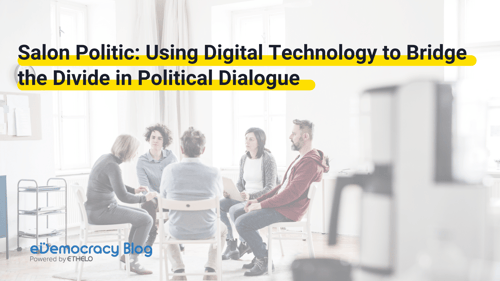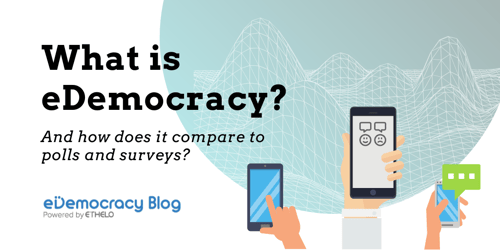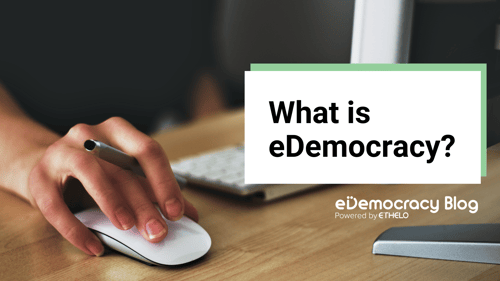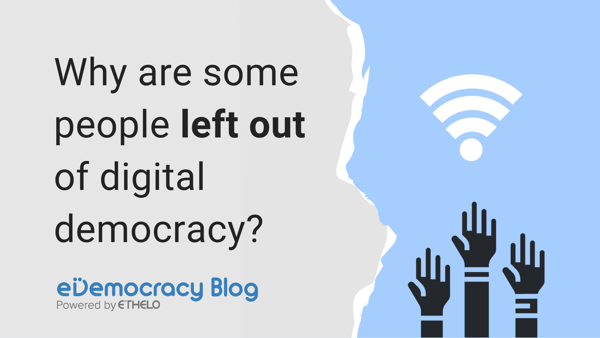
Modern democracies have evolved more in the last few months than they have in the past century. Digital tools, live-streaming capabilities, and sophisticated technological platforms are changing how local governments engage their communities on the critical decisions to be made during and after the pandemic. Digital democracy is making exciting progress, but how accessible is it to the people it serves? On the one hand, digital tools can support thoughtful deliberative policy-making and foster an informed, representative public. On the other hand, a hasty shift to the online world threatens to leave behind anyone who falls on the wrong side of the digital divide.
In terms of civic participation, there are significant benefits to bringing democratic processes online. The place-based nature of democracy has never been fully accessible to all. For anyone that juggles multiple jobs, care-giving responsibilities, and disabilities like social anxiety, the cost of showing up to a town hall or an open house can be high. Remote options for participation can re-engage those who have been excluded, which in time leads to a political system that better reflects the society it seeks to represent.
At the same time, a democracy that is solely digital won’t be an answer to universal accessibility. Though Canadian households have seen rapid growth in Internet connectivity over the past decade, real gaps in Internet access still remain. The issue now is with speed. Only 37% of rural households and 24% of Indigenous households in Canada have access to Internet speeds that are fast enough for anything beyond checking email and using social media. This is barely sufficient for basic activities like online work and school, let alone tuning in to a video-conference town hall.
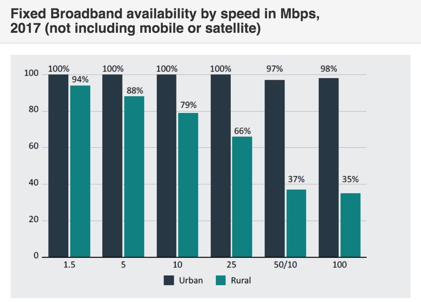 To take full advantage of the opportunities offered by the modern Internet, speeds of at least 50/10 are needed. Image from Innovation, Science and Economic Development Canada.
To take full advantage of the opportunities offered by the modern Internet, speeds of at least 50/10 are needed. Image from Innovation, Science and Economic Development Canada.
This ‘digital divide’ typically references the gap between the Internet haves and have-nots, but the term is also rooted in the idea of differential access to information. When community members have the ability to gather information about the issues that affect them, they can make empowered decisions about their lives, provide important input to decision-makers, and feel a greater sense of control over largely unpredictable situations. An informed citizenry is at the heart of democracy - so much so that it’s codified in law. Recently, we wrote about how local governments in British Columbia have a legislative requirement to provide the public with enough information to form rational opinions on policy proposals, and accessible channels through which to leave feedback. Now, the dual challenges of physical distancing measures and the digital divide are raising questions about how to satisfy this requirement.
Lyndsay Poaps, former Executive Director of Leadnow, spoke at a recent eDemocracy Webinar. She believes that “We’re at a tipping point where we’re actually realizing that internet, data, and a strong phone connection are essential services...And I think that we need to regulate it in the way that you would regulate hydro.” According to Poaps, recognizing connectivity as an essential service will take a major advocacy push for infrastructure development and mandated affordability. Until then, however, bridging the digital divide in democracies will require meeting people where they’re at - literally, in the safety of their homes, and figuratively, regardless of their ability to go online.
In the Webinar, Poaps described the idea of a “low floor and a high ceiling” for digital engagement. This means lowering the barrier for entry first and then giving people the room to dive in as deeply as they want to on a given issue. Democracy online will play a part in building out that low floor for many people, and new civic engagement technology can raise the ceiling under which to engage. But making engagements universally accessible also means working with the lower-tech communication methods that people continue to rely on. Think of the humble landline phone: in 2016, 30% of the lowest income Canadian households still relied solely on a landline. Given that COVID-19 disproportionately affects people living in poverty, local governments must consider how best to deliver critical information to these households, as well as seek their input on the policies that will affect them.
.png?width=456&name=Digital%20Divide%20Blog%20(3).png)
Effective digital engagement uses a "low floor" and a "high ceiling".
Accessibility could also mean legitimizing the ways that under-represented communities prefer to engage. “Let's not act like the voiceless are completely without voice,” said Ginger Gosnell-Myers, an Indigenous Fellow at SFU who also spoke at the eDemocracy webinar. “They are reaching out and creating a virtual and digital community already.” Gosnell-Myers’ own Nisga’a community actively uses social media to voice their concerns, but they don’t see a lot of uptake from elected officials on these platforms. “I think we need to just get used to engaging online, because it's the simplest form of hearing from community members that don't traditionally feel that they have access to decision makers.”
The pandemic has jump-started a trial run with new technologies and strategies that may otherwise have taken years. The jury is still out on whether local governments will return to the way things were before, post-pandemic. If digital democracy is here to stay, now is the time for decision-makers to consider how they can use these new methods to increase accessibility and inclusivity in public engagement. Harnessing the full power of digital technology, while also working to engage people at the level of their abilities and preferences, will benefit society long into the future. The bottom line is that finding new ways to reach out to people despite the barriers is not just the right thing to do; it’s a democratic imperative.
Everyone deserves the chance to participate in the decisions that will impact them - and that means reaching beyond the usual suspects in your engagement. With Citizens' Panels, Ethelo's participant recruitment service, our engagement & communication experts help you overcome communication barriers in order to hear from all of your key stakeholder groups.
Bonus: download our ultimate checklist of steps for effective, equitable engagement below.


